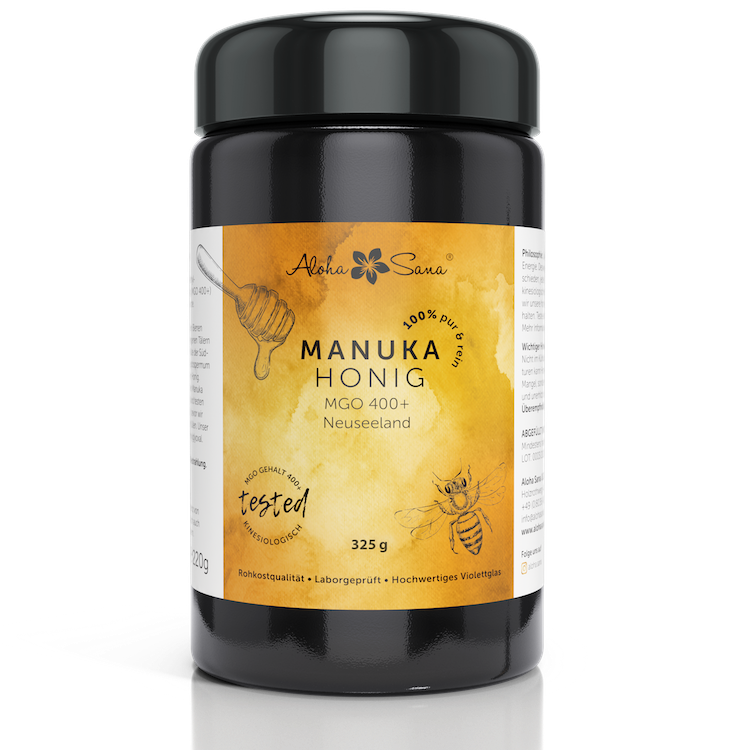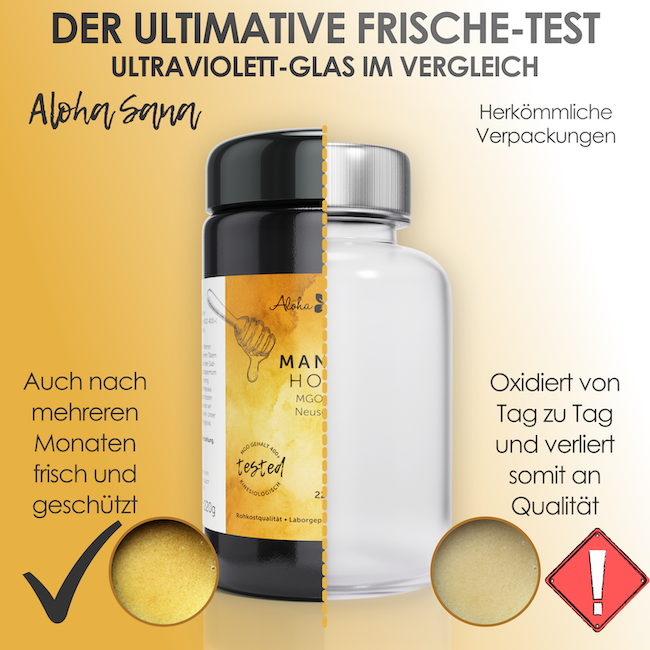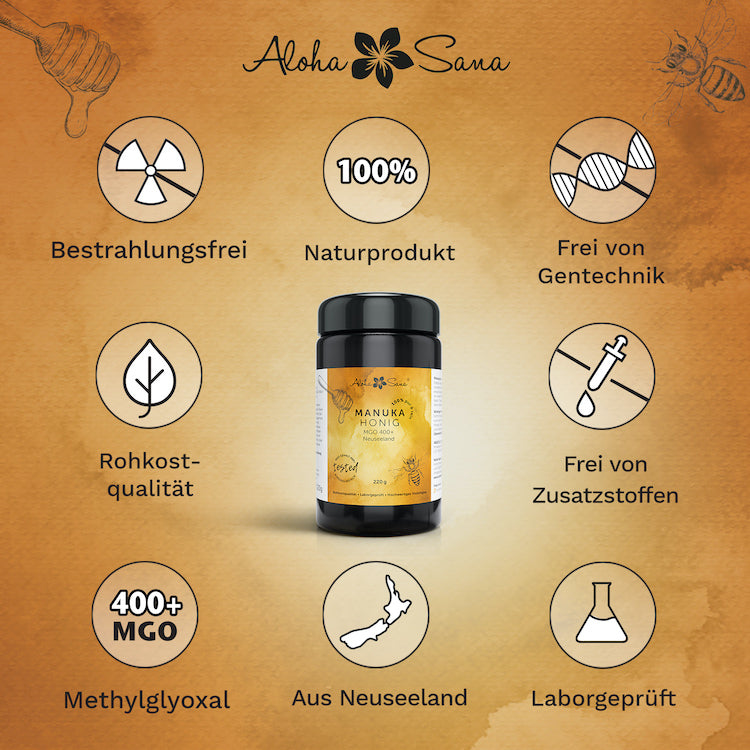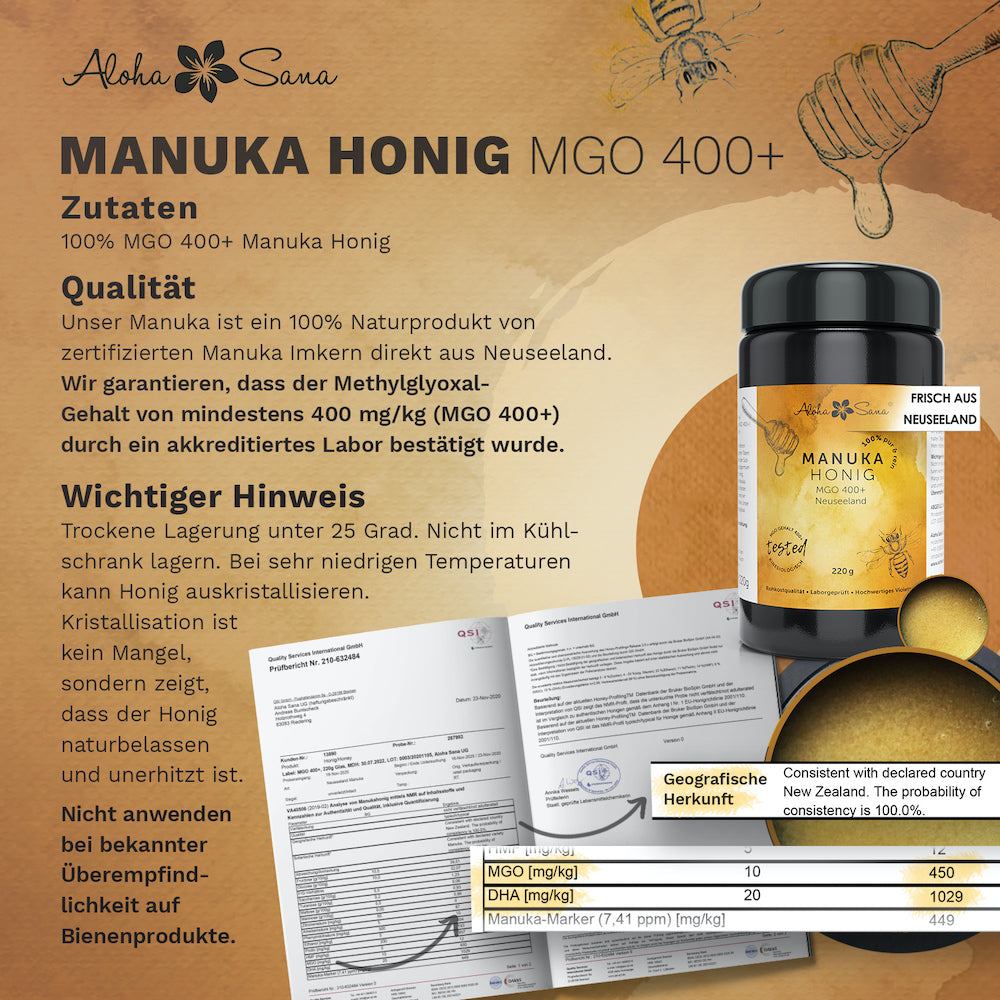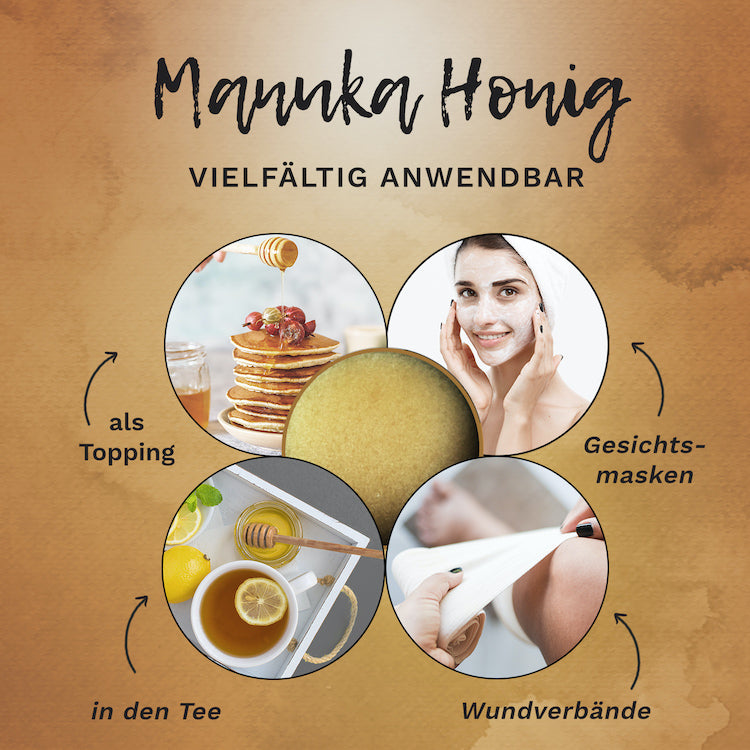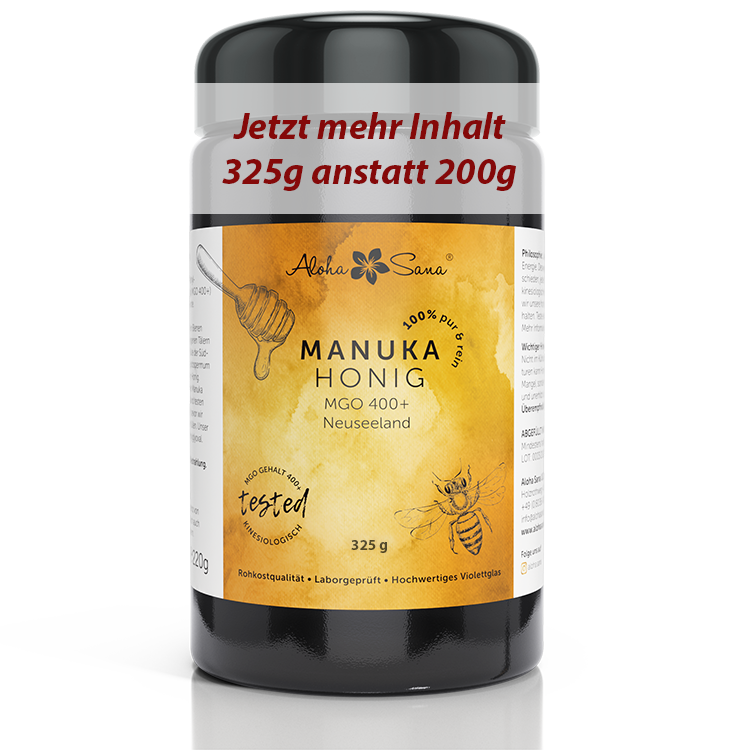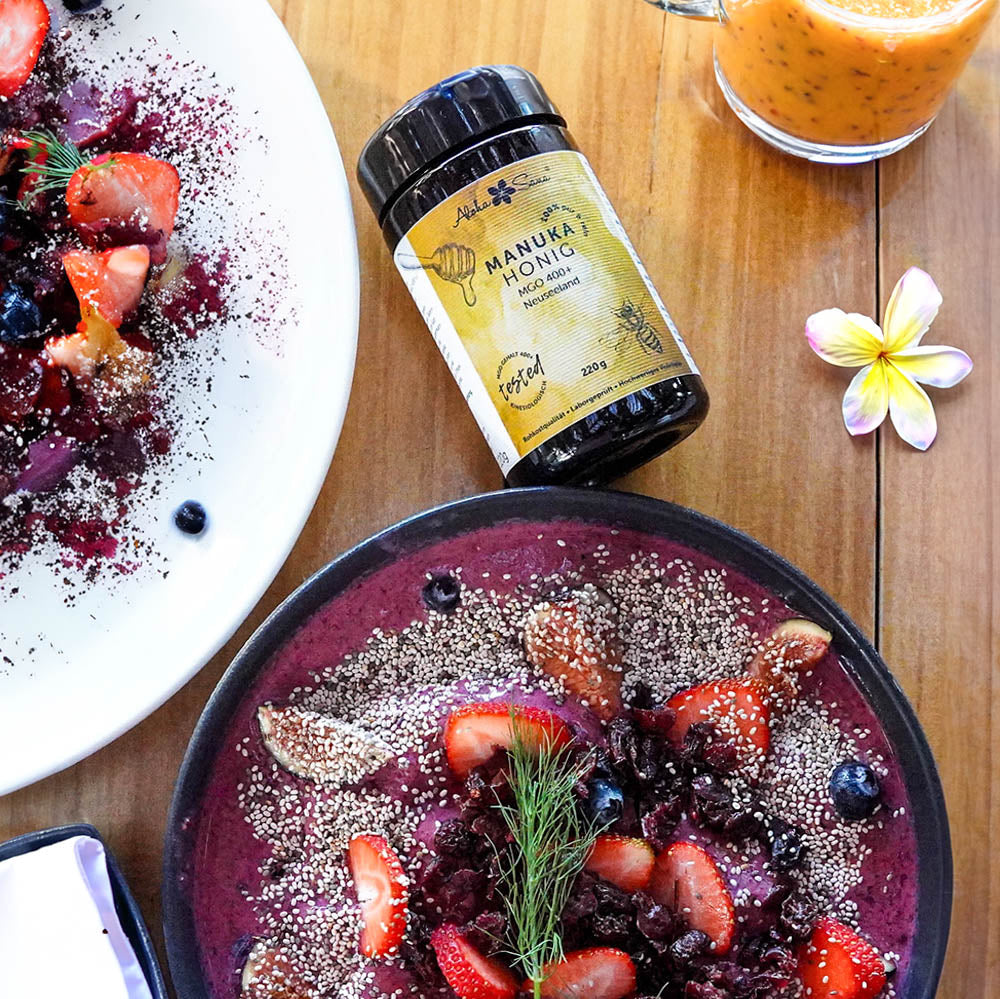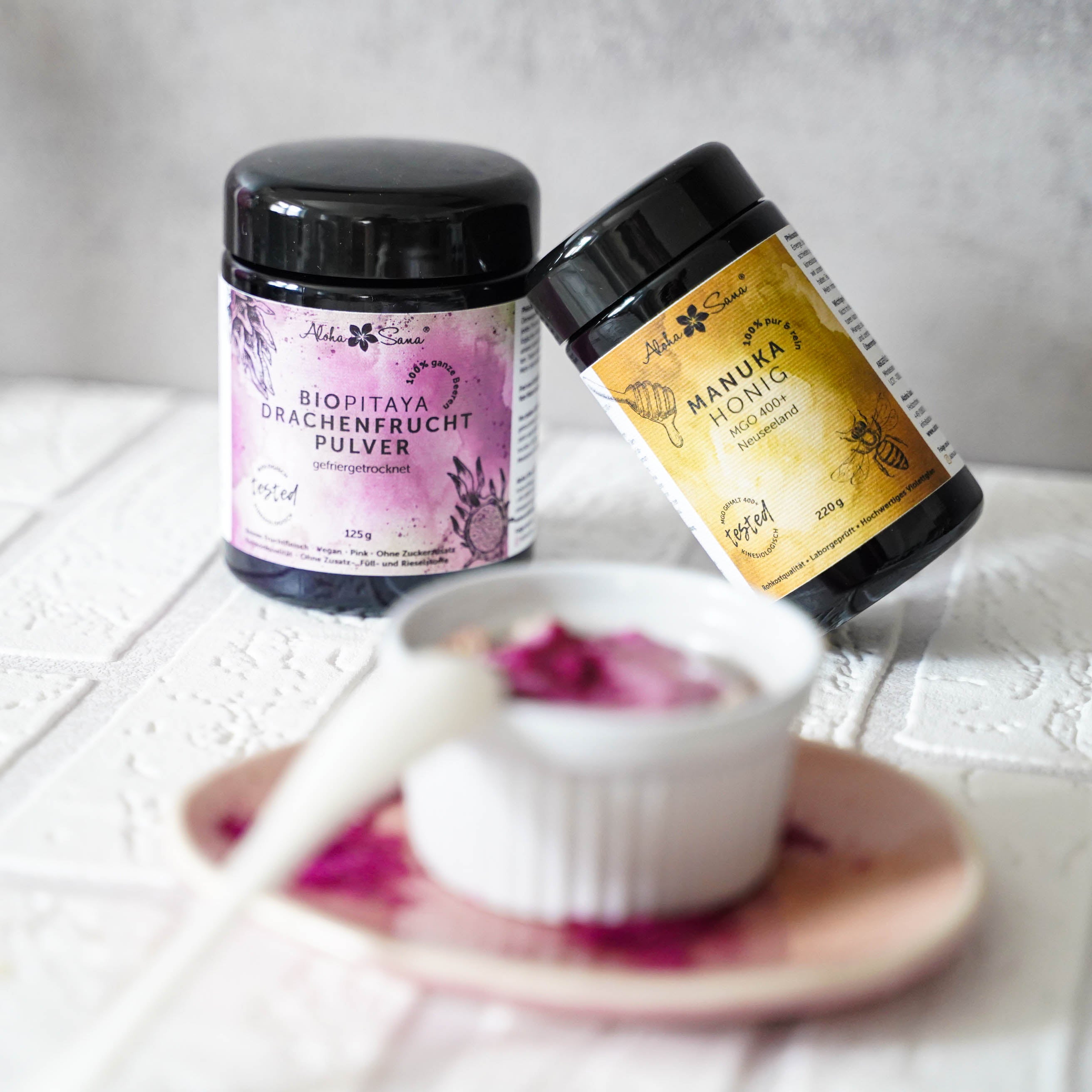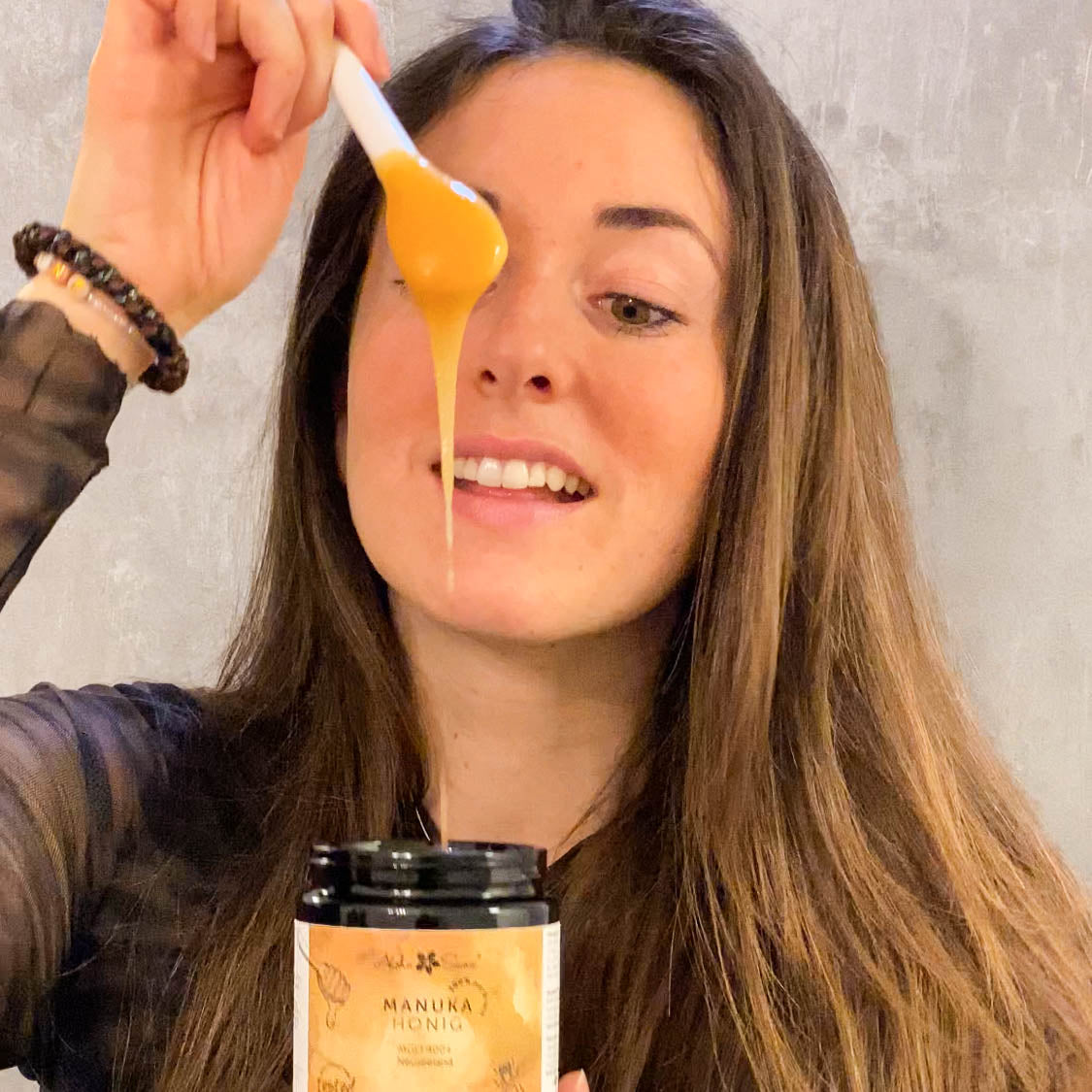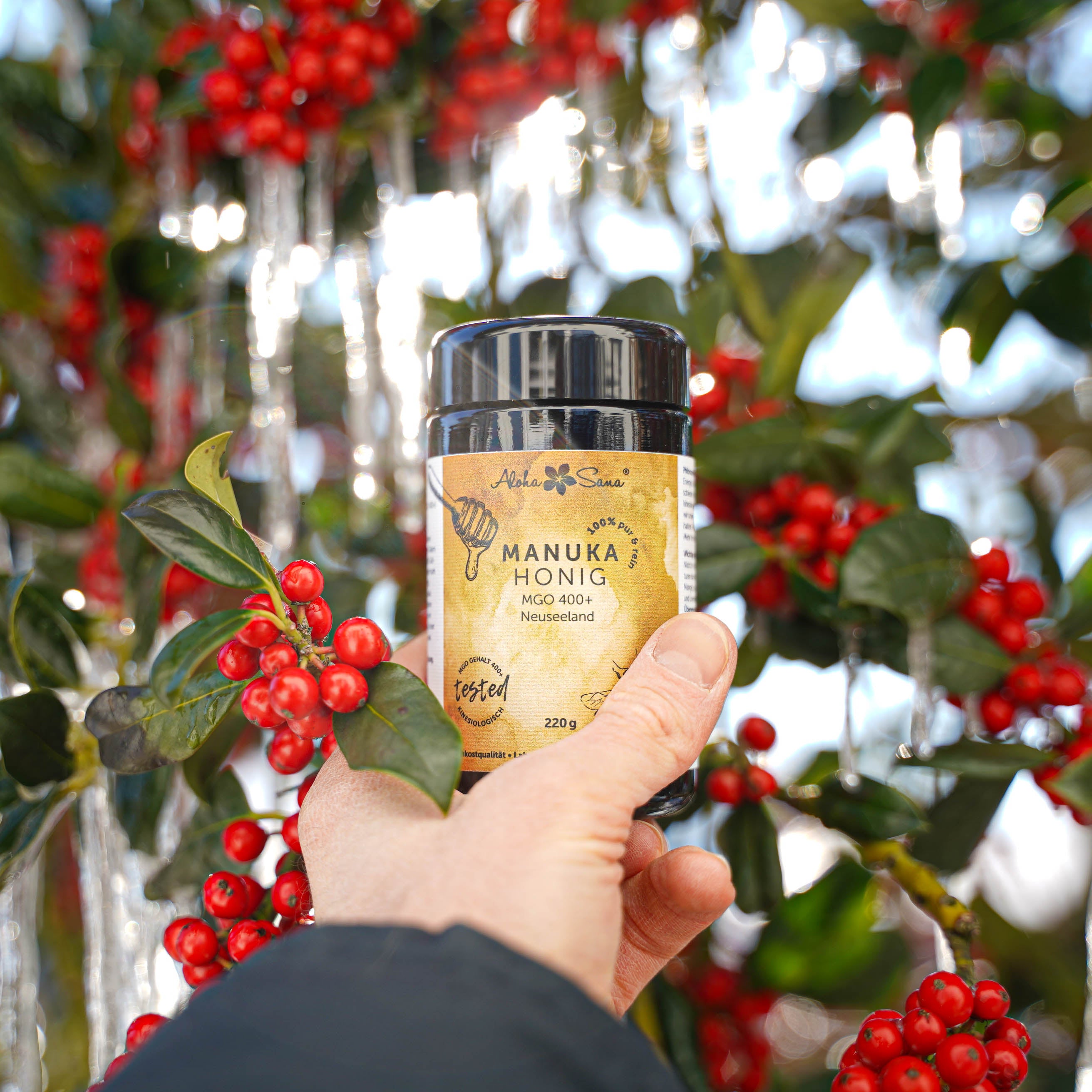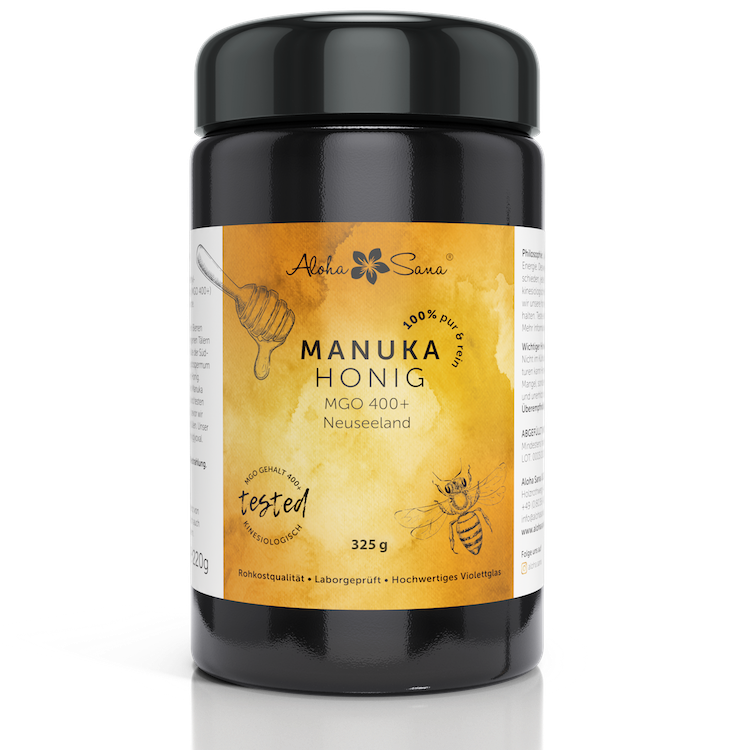
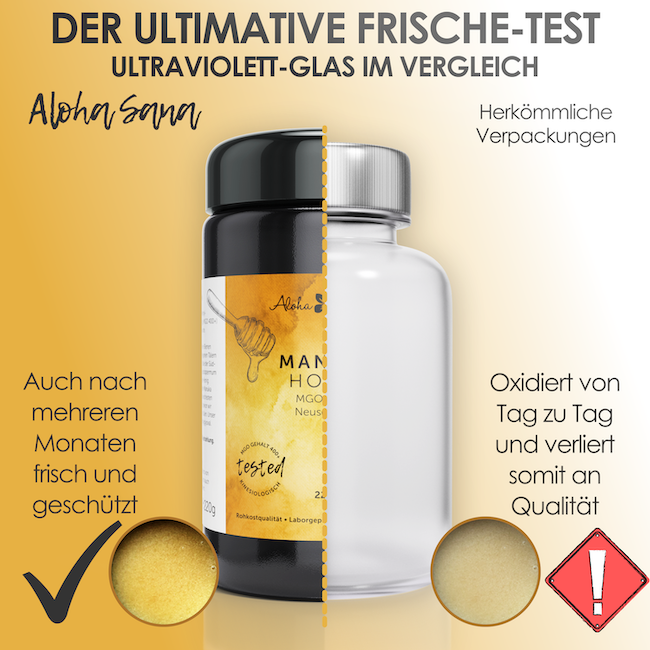
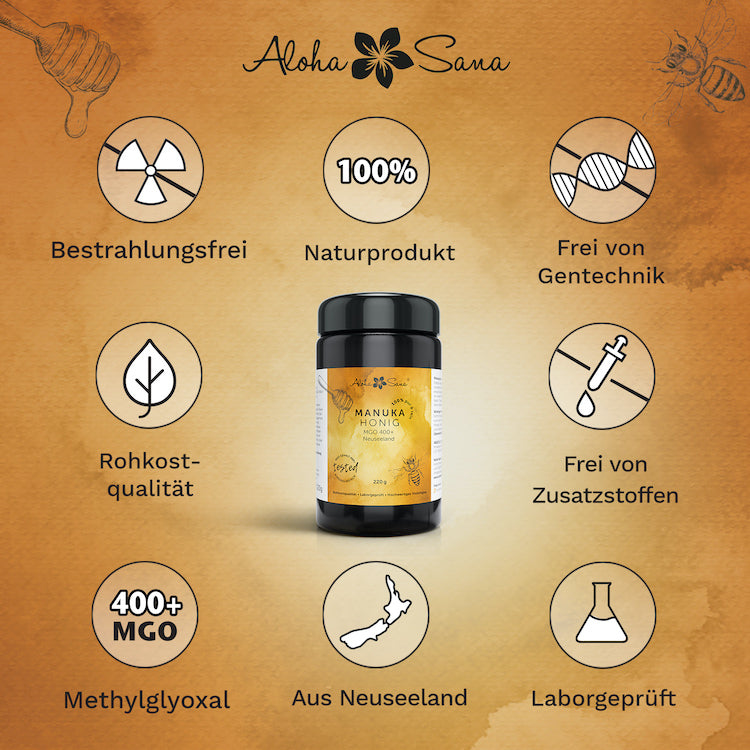
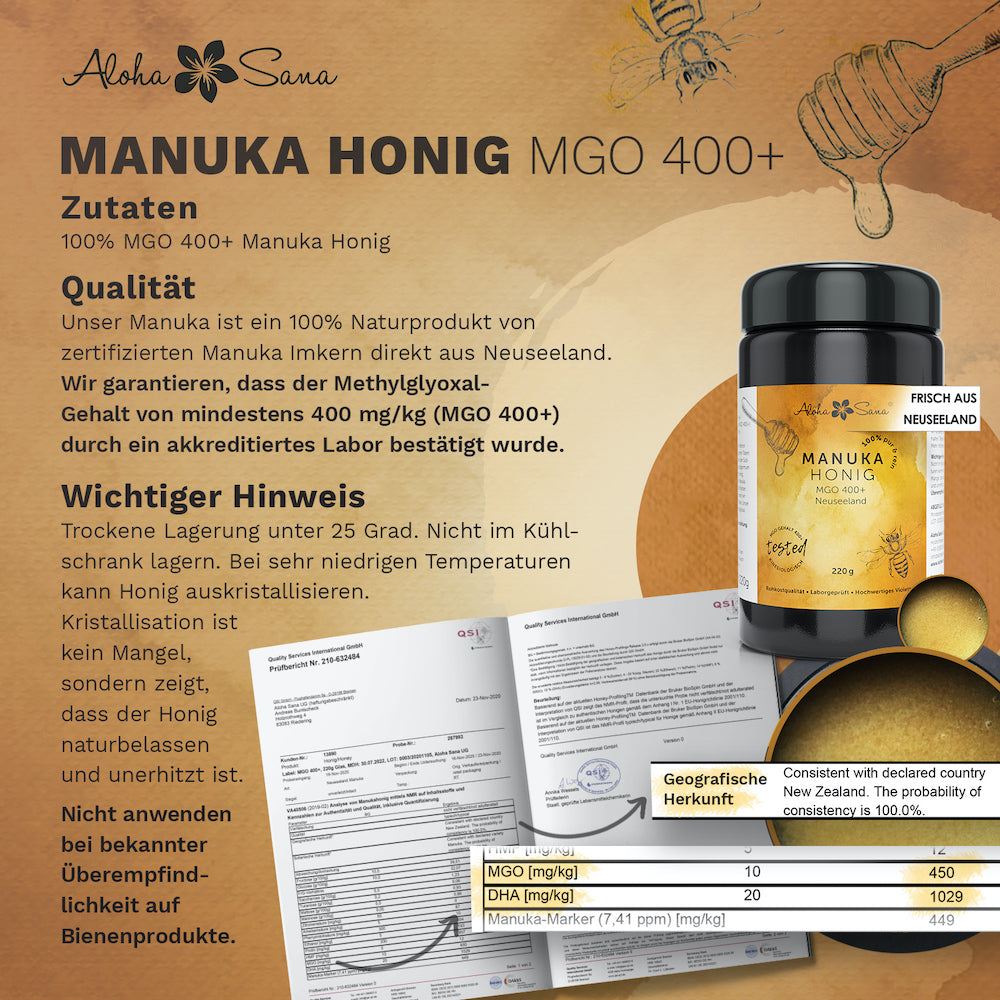
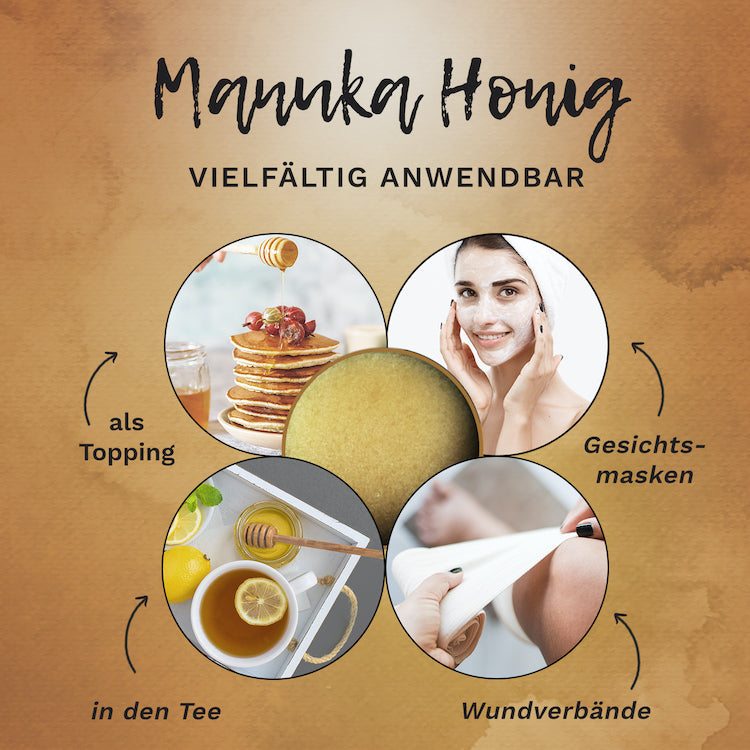

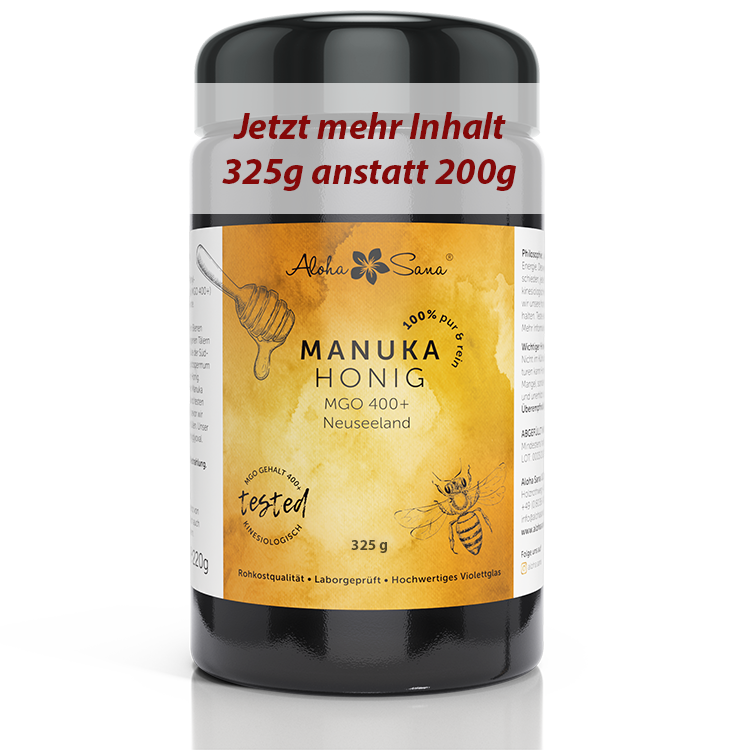
-

Laboratory-tested real Manuka honey from New Zealand
-

100% natural, bottled without additives
product details
🇳🇿 100% New Zealand
We attach great importance to the purity of the honey. We found the best Manuka honey in New Zealand. Only from there can we guarantee a high MGO content. All our batches are tested for MGO and DHA content
🇩🇪 Bottling WITHOUT heat
Our Manuka honey is brought to Germany in large barrels . Here the honey is filled into our violet jars without heat . Our process is deliberately slow because we do not use heat to liquefy the honey. This would allow us to fill it more quickly . We reject this because we would destroy nutrients and the good properties of Manuka.
🐝 More natural than organic
Quality: Our hardworking New Zealand bees collect our Manuka honey in remote valleys and mountain areas of New Zealand. They extract this precious honey from the blossom of the southern myrtle , the Manuka tree (Leptospermum scoparium).
We only import honey from certified Manuka beekeepers directly from New Zealand. Free from genetic engineering, additives and irradiation. No subsequently added MGO.
🍯 High MGO content
Manuka honey is particularly known for its high MGO content . MGO stands for methylglyoxal and is very popular as a natural antibiotic (antibiotics). The higher this proportion, the better the effect. We guarantee an MGO content of at least 400+ .
🔆 Natural substances MUST be in the glass
Manuka honey oxidizes over time in plastic containers and loses quality from the day of production. In the VIOLET GLASS this is impossible, as it increases the shelf life and also maintains the freshness and quality
Our violet glass also prevents the biophontones from escaping from the raw material.
SUSTAINABLE: Too good to throw away, the glass can later be used as a spice jar, etc.
🔬 Laboratory tests are NOT enough for us
We test both in the laboratory and energetically using the kinesiological method. 9 out of 10 products fail this test. Aloha Sana is recommended by alternative practitioners , kinesiologists and therapists because our products harmonize with the body and strengthen it.
More information
💬 Origin and information
Origin: New Zealand
Storage: Store in a dry place below 25 degrees. Do not store in the refrigerator. At very low temperatures, honey can crystallize. Crystallization is not a defect, but shows that the honey is natural and unheated.
Use in combination with medication or with pre-existing conditions:
As a manufacturer, we are unfortunately not allowed to provide medical advice. Please contact a doctor or alternative practitioner of your choice.
Notes Allergens:
Do not use in case of known hypersensitivity to bee products
Durability:
The best-before date and LOT number are on the label.
📊 Ingredients
Ingredients: 100% MGO 400+ Manuka honey from New Zealand
MGO content: We guarantee that the methylglyoxal content of at least 400 mg/kg (MGO 400+) has been confirmed by an accredited laboratory.
Content: 325 g
📖 Effect
Due to legal regulations, we are often unfortunately unable to provide precise information on the effects of certain components of our products.
This explains why some product information is very limited or even non-existent. If there is too little or no specific information about the effects provided for you, you are invited to do your own research. We ask for your understanding.
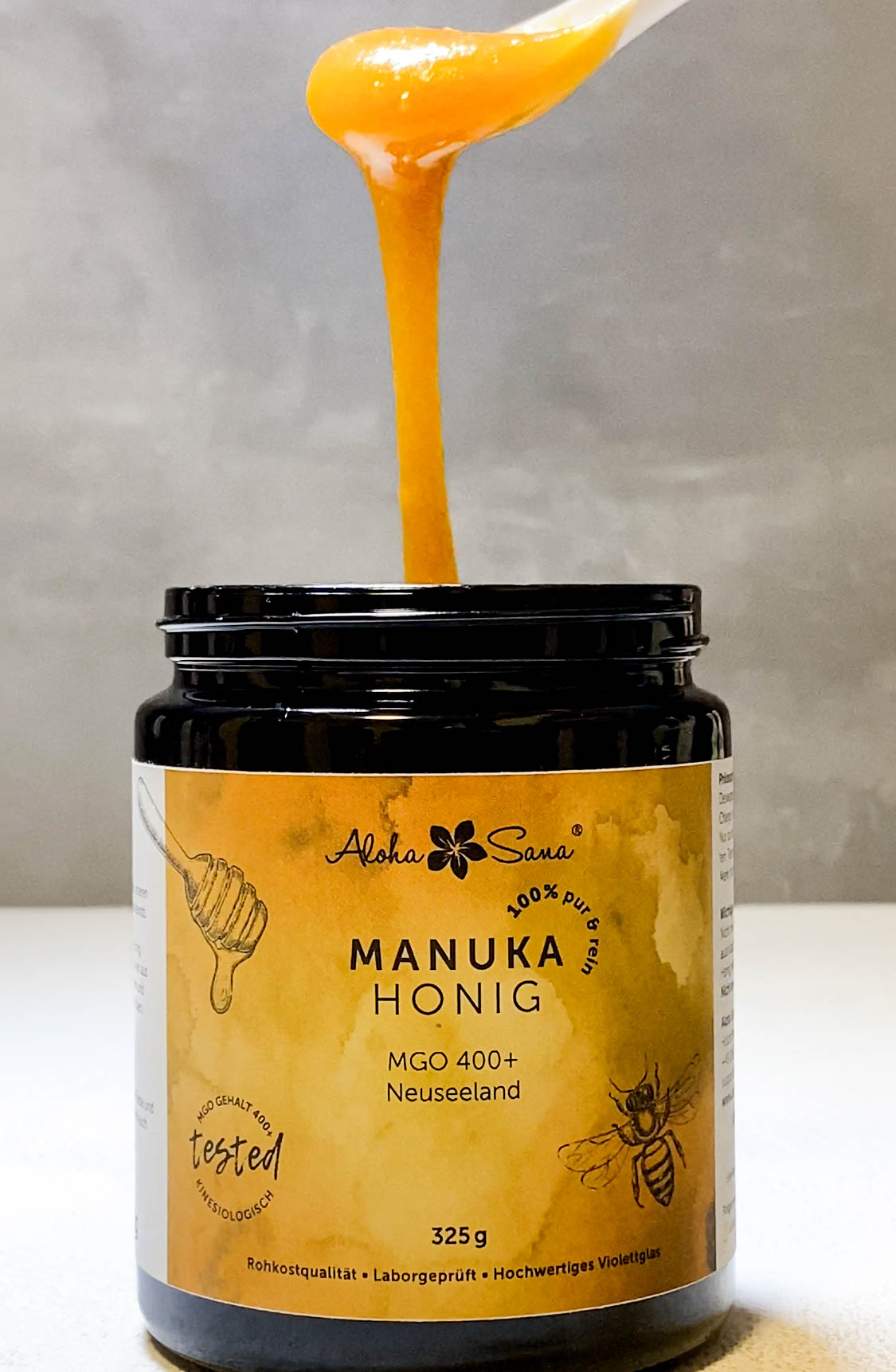
More Manuka sold than produced?
Around 10,000 tons of New Zealand Manuka honey are sold worldwide every year . Only around 2,000 tons are actually produced .
This shows that there is an incredible amount of adulterated and even completely fake Manuka honey on the market. Unfortunately, there are a lot of half-truths on the Internet about how to recognize real Manuka honey.
Smell , taste and color are often mentioned as parameters, but unfortunately this is not an indication of real Manuka honey. Only the laboratory can confirm this.
Frequently Asked Questions
to Manuka
What color should Manuka be?
Manuka is a 100% natural product . Therefore, the color has a natural variation . Fresh Manuka is generally lighter than older Manuka. A very high MGO content (over 700+) tends to be darker than a medium MGO.
It is often claimed that with a lighter Manuka honey you have to be careful that it has not been mixed with acacia honey and others claim that with dark Manuka you can be just as “fooled” by mixing forest or fir honey .
As you can see, the color is not really a criterion that you can rely on. In general, you should be able to classify Manuka honey as being between light and dark brown . Only the laboratory can give certainty here.
How do you test the authenticity of Manuka?
Only a laboratory test can provide 100% certainty. Our certified laboratory is known especially for honey, especially Manuka honey. In addition to MGO, the DHA content is also determined here.
Many people are unaware of the connection between the two. DHA is the precursor to MGO . The longer the Manuka is stored , the higher its MGO content becomes, as DHA is converted into MGO.
However, there is no complete conversion of DHA into MGO. But this is where cheating can occur: MGO can now also be added artificially .
That is why the balance between DHA and MGO is so important . A DHA content that is too low indicates an unnatural MGO. Our MGO content is determined in the laboratory to be 446 and the DHA content to be 1223. These are excellent values.
We also use NMR to test for ingredients and indicators of authenticity and quality. This gives us maximum certainty that our Manuka honey really comes from New Zealand and is pure.
If I have questions, is there someone who can help me?
You can reach us at any time at support@alohasana.de . We would also be happy to arrange a free
Make an appointment by phone. Please make an appointment by email.
My Manuka is crystallizing, why?
Compared to other types of honey, Manuka is more viscous . At temperatures below 15 degrees, the Manuka begins to crystallize . However, this is not a defect and can be reversed by warming it up .
It has an optimal consistency at normal room temperature of around 20 degrees . The incredibly beautiful spoon photos of Manuka honey flowing down quickly are only possible because they were taken with warmed Manuka honey or in a warmer environment in a photo studio.
In general, Manuka should never be heated above 40 degrees (be careful with tea . Allow to cool first), otherwise important nutrients are lost.
Can Manuka be put in tea?
Definitely, but please let it cool down first (below 40 degrees), otherwise the nutrients will be destroyed.
General Questions
satisfaction guarantee
If you find within 30 days that our product does not fully meet your expectations, simply send it back to us and we guarantee a full refund of the purchase price.
Please note that as a young family business we cannot cover the shipping costs for returns. If you have any questions, our customer service team will be happy to help you.
What is the best way to store the products?
It is important to understand that our products do not contain any additives. This means that there are no stability additives like those used by other companies, which sometimes do not have to be declared ...
Therefore, always screw it on tightly. Do not store it in a place that is too warm (below 21 degrees) and do not place it in direct sunlight.
For blueberry, dragon fruit and vitamin C capsules, we definitely recommend storing them in the cellar or even the refrigerator for longer periods of time. Once opened, these three products should be consumed as freeze-dried powders absorb moisture from the surrounding air and some of it gets in every time they are opened.
Can I take all the products together?
That depends. First of all, it is important to understand that we are talking about "whole foods". All of our products, except for D3K2 and K2, are whole foods. They contain a wide range of nutrients. The nutrients are utilized step by step in the digestive process at the right time and in the right place.
But if you have a mono selenium and a mono vitamin C, then they can cancel each other out.
If you have mono nutritional supplements from other companies, please separate them from ours, because natural and unnatural substances should be separated.
A few rules of thumb: keep green foods like spirulina away from antioxidants (vitamin C etc.) for 1.5 hours. Chlorophyll is not supposed to be completely compatible with antioxidants. But again, the statement goes: a "whole food" also has everything in it, so this is just a tip if you combine other food supplements with ours.
How else can I use the alkaline bath?
- An additional and quicker option would be a foot bath of at least 30 minutes. This can be done as often as you like per week. A full bath is clearly more effective.
- Customers tell us that they also inhale the mineral salt on certain occasions. When inhaling, simply put 1 teaspoon of mineral salt in a bowl of warm water, then cover your head with a tea towel and breathe in deeply. (approx. 5 - 7 minutes)
- Nasal rinses : Dissolve 1 pinch of mineral salt in a 200 ml glass of water. Pour this water mixture into a tablespoon and pull it up through each nostril alternately about 3 times. Important: Then rinse your mouth 5 times with the remaining mineral water for about 1 minute and spit it out.
Bathing for so long?
You should bathe for at least 60 minutes, as the pores only open after 20 minutes . This is different for hands and soles of the feet, armpits, elbows, and the backs of the knees, where it goes much faster , as these are the elimination points .
That's why wraps and alkaline showers are effective in these areas and you don't have to wait 20 minutes. But with an alkaline bath , the longer the better .


